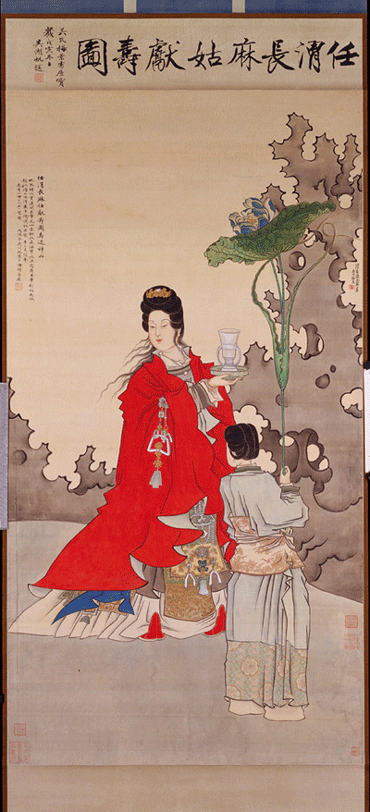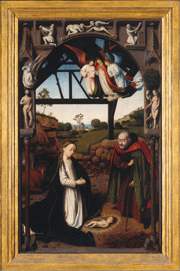
Ren Xiong, Mistress Ma presenting a birthday gift, c.a. 1800-1850, Palace Museum, Beijing
|
|
CENTRE FOR FINE ARTS BRUSSELS
Entrance Rue Royale 10 1000 BRUSSELS
INFORMATION:
Tél. : +32 (0) 2 507 82 00
E mail : info@bozar.be, tickets@bozar.be
BOZARPODCAST: www.bozar.be
OPENING HOURS:
Tuesday-Sunday: from 10am to 6pm
Thursday: from 10am to 9pm
Monday: only on reservation for groups of 150 +
PRICES OF ADMISSION:
Full price: 7€.
Reductions: 6,3€ (BOZARCARD/Knack Club),
5,25€ (Davidsfonds, Fed+),
5€ (-26,+60,students,groups),
3€ (-18, schools, teachers, jobseekers),
Free (-12,Brussels Card, Pass Mont des Arts, pers.in a wheelchair and accomp.).
Other reductions on www.bozar.be
Combiticket "Forbidden City-Views on Europe": 14€, Reductions : 10€ (-26, +60, students, groups), 5€ (-18, schools, teachers, jobseekers)
CURATORSHIP:
Luc Tuymans
Yu Hui, curator at the Palace Museum in Bejing.
PRESS CONTACTS:
T: 0032(0)2 507 83 89; fax: 0032(0)2 507 85 15
E mail: press@bozar.be
Leen Daems (BOZAR EXPO)
T: 0032(0)2 507 83 89; T: 0032(0)479 98 66 07
E mail: leen.daems@bozar.be
Canan Marasligil
T: 0032(0)2 507 83 91; T: 0032(0)476 98 68 24
E mail: canan.marasligil@bozar.be
The exhibition title,The Forbidden Empire, is derived from the book by the same name by the Dutch author J.J. Slauerhoff. Slauerhoff worked as a ship's doctor for several East-Indian companies. Consequently he made many voyages to China, Hong Kong and Japan, and later also to Latin America and North Africa. Shortly before he died in 1936 at the age of 38, he remarked that the world had become a much smaller place in terms of distance, but much larger on a psychological level. So rather than serving an exotic purpose, the title of the exhibition expresses the layers of meaning conveyed by the combination of the two world views. Drawings and paintings from the 15th century till the beginning of the 20th century by, among others Van Eyck, Brueghel, Rubens, Van Dyck, Ensor and Spilliaert confront works on paper and silk from the Ming and Qing dynasty and the early Republic of China.

|
A dialogue, which does not detract from tradition
The concept of the exhibition is to initiate a dialogue between Flemish and Chinese world views. The idea is to show the paintings not only as representatives of a genre, but to place them in a wider context so that the two world views of that period can be presented more clearly. How do artists depict movement? How do they convey distance and detail, scale and depth? How important are the narrative element, calligraphy and iconography? What about reproducing shadow, nudity, the idea of original sin, etc.? “We endeavour to open up the dialogue through the visual image, without detracting from the two traditions. We work with 'punctuations': for example, two Chinese group sculptures are punctuated by a Western work comments Luc Tuymans.
Brussels and Beijing
The exhibition's locations - first the Centre for Fine Arts in Brussels, then the Palace Museum in Beijing - played an important role in the elaboration of the concept. The Centre for Fine Arts has since its foundation been a multipurpose venue where various artistic disciplines meet and interact. The institution has no permanent collection. The Palace Museum, conversely, houses a huge art collection. It is based in the Forbidden City, which stands as a symbol of steadfastness and harmony, a centre towards which everything converges, and for a culture that is over 5000 years old, a centralized power, regardless of political change and upheaval. The West, in contrast, has been burdened by many changes in governance, resulting in a fractured approach to the process of perception and patterns of visualization, which immediately adjusted to the worldly and religious regime. Thus the path was cleared for visual thought, which continually gained new form within the context of circumstances and as a reaction to them. Classical Chinese art avoided these areas of tension and, from the basis of the idea of harmony, focused on the image.
The Forbidden Empire will travel on from the Centre for Fine Arts to the Palace Museum in the Forbidden City, where it can be seen from June 27th 2007.
Illustration: Petrus Christus, The Annunciation, 1452, Groeningemuseum, Brugge O Reproductiefonds Vlaamse Musea NV
To see more illustrations, click on VERSION FRANCAISE at the top of this page
|









